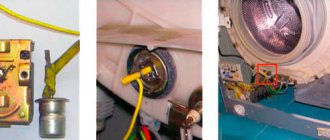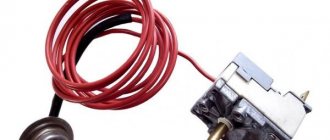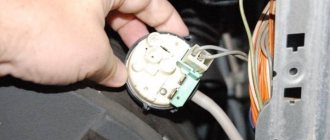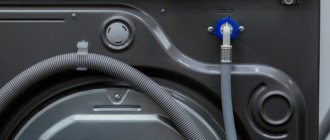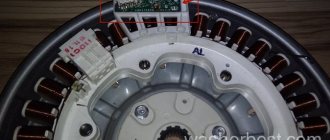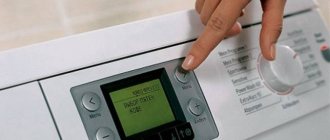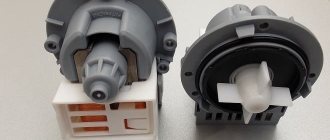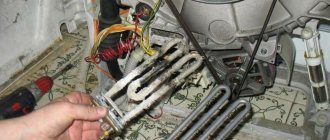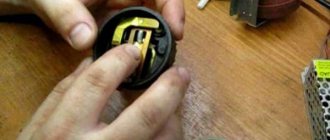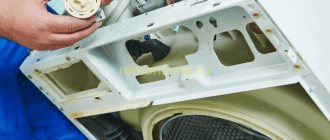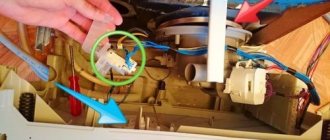Any model of washing machine is equipped with a sensor that is responsible for the amount of water drawn into it. The fact is that at different washing modes, the volume of water in the tank can vary significantly. The water level sensor in the washing machine, which is also called a pressure sensor, level switch or simply a pressure switch, is responsible for this correspondence. Depending on the settings of the machine, it gives a command to draw water, and then to turn it off.
The main function of the sensor is to check the presence of water in the tank and determine its level. If for some reason the sensor does not work, it will be impossible to wash the clothes normally.
Operating principle of the pressure switch
Each washing machine is equipped with a water level sensor (pressostat). It serves to supply an electrical signal to the washing machine controller about the presence or absence of water in the tank to perform further operations according to the established washing program.
A standard pressure switch consists of a disc-shaped sealed housing, inside of which there is an air chamber. A tube is connected to it through a fitting, the second end is lowered into the tank of the machine. When water enters the machine, the air pressure in the tube and chamber of the pressure switch increases. The sensitive membrane begins to lift the rod, which presses on the spring-loaded contact plate.
When a certain level of liquid in the tank is reached, the spring plate clicks into the upper position, closing the electrical circuit of the sensor input lamellas.
If the contents of the tank are drained, the pressure in the chamber decreases, the rod moves down and the contact plate switches to the lower position, breaking the electrical circuit. Based on the pressure switch signal, the controller issues control signals to other actuators (exhaust pump, motor, inlet valve, heater relay). See also -
What to do if the washing machine does not open after washing?
Appearance
The design of the simplest electromechanical unit is a cylindrical plastic case, inside of which there is an air chamber with a diaphragm, tubes, an inductor with a core and a contact group of conductors.
The complexity of the sensor depends on the number of washing programs of the washing machine. Pressure switches differ for different models of equipment, and this fact should be taken into account if it is necessary to replace a failed sensor.
The installation location of the pressure switch differs for different models and directly depends on the design of the machine.
- For machines with classic laundry loading and a steel drum, the sensor is located under the top cover.
- For models with top loading of laundry items, the pressure switch is installed below the tank.
- For washing machines equipped with plastic drums, the sensor is located in the rear of the housing.
Option for the location of the pressure switch in the washing machine
Signs of a faulty water level sensor
Failure or malfunction of the pressure switch leads to problems with the operation of the washing machine. Externally, signs of a faulty water level switch may look like this:
- the machine washes or turns on the heater when there is no water in it;
- the tank is overfilled with water or, conversely, there is clearly not enough water for washing;
- when the rinse mode is turned on, liquid is periodically pumped out and supplied;
- the appearance of a burning smell and the activation of the heating element fuse;
- The laundry is not spun.
The appearance of such signs should be a reason to check the functionality of the pressure switch, for which you need to arm yourself with a screwdriver with replaceable heads, since many manufacturers use fasteners with special heads to protect against unauthorized access.
See also:
The drum in the washing machine does not spin
Examination
An independent check will help identify only obvious damage to the part. Only an experienced technician can adjust the sensor without special measuring equipment.
Check the following aspects yourself.
- Safety of body parts. There should be no obvious mechanical damage on the sensor. Violation of the integrity of the device body is unacceptable; this interferes with proper operation.
- Clean contacts. Contaminated ones are cleaned, and if the sensor is severely burned, the sensor is replaced (the cause of the burning is a malfunction inside the relay).
- Membrane integrity. To check, attach a piece of hose of a suitable diameter to the inlet fitting. By blowing into the tube, listen for clicks caused by the closing or opening of the contacts inside the sensor.
Important!
The clicks themselves only indicate the integrity of the membrane. The operation of the contacts is checked with a multimeter - when they are closed, the measuring device will show a resistance value of “0”. Any other readings indicate a relay malfunction.
How to check the pressure switch yourself
The above deviations in the operation of the washing machine may be the result of a malfunction of other parts, so you need to check the functionality of the pressure switch before installing a new one. To do this, it must be removed from the machine. Where is the water level sensor located in the washing machine? In order to find and check the pressure switch, you must perform the following steps:
- Having unscrewed two bolts from the back of the washing machine, you should remove the top cover of the machine with a shift back;
- on the side wall, find the pressure switch secured with screws, disconnect from it the connector with wires and the hose connected to the fitting using a clamp;
- Unscrew the fastening bolts and remove the block.
Carefully inspect it and the tube for external damage or blockages. If necessary, clean the tube and fitting. The outer lamellas on the connector must be clean without traces of oxidation. If there is dirt or corrosion, they should be cleaned. The functionality check must be carried out in the following order:
- Place a small hose on the fitting and, holding the block to your ear, blow into the hose. When the sensor contact is triggered, a clear click should be heard.
- Depending on the design of the block and the number of contact groups, the number of clicks when blowing the hose can be one, two or three. The absence of clicks indicates a malfunction of the device.
- You can verify that the contacts operate reliably using an ohmmeter by connecting it to the corresponding sockets on the input connector of the unit. When the contacts are closed and opened, the readings of the device will change sharply. The electrical diagram of the connections of the contact groups of the pressure switch can be found in the operating instructions for the washing machine.
See also -
The washing machine does not drain water - what to do?
How to find out about a breakdown
A pressure switch is a specially designed part necessary to control the level of water or other liquid and not only in washing units. It is used in many technical devices where it is required. This device signals the remaining amount of gasoline or other fuel in the car’s gas tank, is used in compressor units, and with its help it is easy to control the amount of windshield washer fluid.
Washing, including heating and rinsing in the machine, depends on the water level and the uninterrupted operation of the pressure switch. If a malfunction occurs during the operation of the washing machine, this circumstance can be immediately noticed by the following criteria:
- The washing process has started, but there is no or little water in the drum.
- The spin program has ended, but the laundry is still damp.
- When the tank is empty, the heating elements turn on.
- Water is poured into the tank above the established level, and overflow is also observed.
- After finishing the wash, the waste water is not drained.
- The Rinse program does not start at all.
All of the above may be a consequence of wear of the pressure switch, as well as a violation of the recommendations for operating the equipment. If the filter is clogged, then the water may also not drain, and the heating elements receive a command to start them.
If the voltage indicator is low, then this ultimately provokes a malfunction of the components and individual elements of the washing unit. If the machine cannot be programmed to check the pressure switch, you must check its serviceability yourself. There are cases when it is simply clogged with debris, but most models provide lighting in the event of a failure. It’s not difficult to determine this; just look at the device’s passport or operating instructions. Different manufacturers have their own fault coding, for example:
- The technical device from Indesit or Ariston reads: F05 or F11.
- Bosch unit: F18 or D 02. D 03.
- Popular manufacturer of Lg equipment: OE/
- Global manufacturer of household appliances Samsung: E2.
- Electrolux company: E F1.
- A company engaged in the production of washing units of the Ardo model: F2.
In any situation, you should initially check the sensor yourself, and only then contact a service workshop. Since malfunctions are also possible for other reasons, for example, the pump has stopped functioning, the filter is clogged, or the rubber gasket is installed incorrectly.
The main difficulty when checking is only inconvenience, because the unit will have to be moved away from the wall or the machine must first be disassembled.
Setting up the water level sensor
The pressure switch is adjusted to the required amount of liquid using two adjusting screws, one of which (central) is used to set the moment of connection of the contacts, and the second (peripheral) is intended to set the moment of their breaking.
There may be several contact groups or sensors depending on the operating modes and model of the washing machine. Programs of different washing modes can also use different amounts of liquid in the washing machine, for example, economical or gentle wash, in which the tank is half filled. Fine adjustment of the alarm is carried out by specialists at the factory, and the position of the adjusting screws is fixed with paint or varnish.
It is not recommended to change their position, as unbalancing the settings will cause disturbances in the established washing program. In order to properly configure the unit yourself, you need to know how much liquid the machine requires at each stage of all washing modes, and in accordance with this, set the moments for turning on and off the contact groups. For example, the pressure switch of a Bosch washing machine has three contact groups configured for full mode, economy mode and tank overflow. See also:
Washing machine jumps during spin cycle
What malfunctions may occur in the operation of the part?
This type of sensor is considered quite reliable, since its operation is based on the mechanical movement of the membrane under the influence of air pressure. However, the possibility of its failure cannot be ruled out. If this happens, the consequences can be very serious, including burnout of the heating element. And this will already entail significant financial expenses.
Are there ways to check the pressure switch in a washing machine? An ordinary person can do this, even without going to a repair shop.
1. Turn off the power to the washing machine by unplugging it from the socket. Carry out further actions only after completing this step.
2. You need to get to the level sensor itself. Since the relay is located in the upper part of the machine body, you need to completely remove its top cover. To do this, unscrew the bolts holding the cover to the body. The cover slides and is removed.
3. Having found the sensor, you should unscrew the bolts holding it, and then remove the sensor itself.
4. The tube and all wires are disconnected from the sensor body. The tube is secured with a clamp that can be unscrewed. If the electrical wires are held on a chip, then to disconnect them it is enough to simply pull this chip out of the socket.
5. The tube is checked for blockages. If there is a blockage, the tube is washed until it is removed.
6. A visual inspection of the sensor is carried out. If any broken elements are found, the sensor must be replaced. The cleanliness of the contacts is also checked.
7. The pressure switch of the washing machine is checked. To do this, you need to take a piece of tube whose diameter corresponds to the diameter of the removed hose. You can also use the removed hose if it is not dirty inside. One end of the tube needs to be connected to the sensor, and blow into the other end. Moreover, you should not blow hard to avoid damaging the membrane.
The cost of the pressure sensor is low, so if you suspect it is faulty, it is recommended to purchase a replacement and install it on the machine.
Procedure for replacing the pressure switch
Once you have confirmed that the water level sensor is faulty, you can replace it with a new one. If the pressure switch malfunctions, you can repair the washing machine yourself. Repairing the water level sensor does not make sense, since its body is non-separable and attempts to disassemble it will lead to damage to the internal parts. The new water level sensor must be exactly the same type and name as the old one, corresponding to the given brand and model of the machine, taking into account the capacity of the loading drum. It also wouldn't hurt to check it before installation. The unit is installed in the reverse order of dismantling:
- secured in place using mounting screws;
- connecting the hose to the fitting and tightening the clamp;
- connecting wiring with a connector;
- installing the top cover and tightening the mounting bolts.
After completing the repair, you should turn on the washing machine and check operation in several modes or perform a test wash.
See also - TOP 10 front-loading washing machines - ranking of the best 2022
What factors may indicate a breakdown?
Blockages in the pressure tube, damage to the surface of hoses and valves, overheating and burning of sensor contacts are the main types of failure of the pressure switch. The source of these problems is the dirt accumulating inside the machine.
Also, to avoid machine breakdown, you should pay attention to the following points.
- Do not allow the washing machine to idle. Before starting the wash, the machine must fill the tank with water.
- The optimal temperature for washing is no higher than 45 degrees. This is enough for high-quality washing of clothes.
A pressure switch is necessary for the entire SMA system. When it fails, it deprives you of the ability to wash, and can lead to various breakdowns. Replacing the pressure switch in an automatic washing machine is a troublesome, but not complicated process. Pay attention to the behavior of your machine, and you will be able to notice a malfunction in time.
The following symptoms indicate that a washing machine malfunction may be caused by a problem with the pressure switch:
- Water did not fill the tank, but the machine started washing. The consequence of such a situation is usually the heating element burns out, since the heater must operate in water.
- There is not enough water in the tank.
- The machine overflowed with water.
- The wash is over, but the water still remains in the tank, so after spinning, you take the wet clothes out of the machine.
- The rinse cycle does not start.
- You smell a burning smell coming from the tank.
Washing consumption
Any washing machine spends a lot of water on washing, and it is not always possible to save money, which leads to financial waste. What determines the consumption of an automatic washing machine? First of all, it depends on the model of the washing machine. Modern automatic cars are equipped with “smart” modes programmed to save money. Therefore, the purchase of a machine should be accompanied by the following knowledge:
- Tank size. A large tank in the machine is the first sign of high water consumption for washing and rinsing.
- Washing mode. Washing machines have many modes: some of them consume a minimum, while others, on the contrary, spend many liters at a time.
- Frequency of SM use. Some housewives do laundry 1-2 times a week. At the same time, they diligently collect laundry in the basket, sort it by color and load the tank as much as possible. So the average consumption will be minimal. But other washing machine owners prefer to wash a small amount of clothes every day. This leads to high water consumption.
- Health status. Those who care about their health are afraid of causing allergic reactions that may occur due to the fact that all the powder has not been washed out of the fabric. Therefore, users select a mode and then set it to an extra rinse. This instantly increases the amount of water wasted.
Important! Have you noticed that when you select the economical mode, water consumption increases? There may be a problem with the washing machine.
The SMA is equipped with a passport in which the manufacturer must indicate the average consumption rate. When studying dozens of SMs, it was calculated that water consumption per cycle is a minimum of 38 liters, a maximum of 80 liters. Let’s calculate on our own how much water a washing machine consumes. The figure today is approximately 59 liters.
Important! If your SMA consumes more, it could be due to serious damage. Take a closer look. If you find a malfunction, contact an experienced technician.
What is the water consumption in the washing machine
Most people, when going to buy a washing machine, began to consider an important characteristic - the average water consumption per time. This factor must be taken into account, because today few things are washed by hand, and this leads to the consumption of a huge monthly volume. If you are wondering how much water a washing machine takes and uses, the average is up to 1/4 of the total water consumed by three people. Therefore, it is very important to think about choosing economical washing machines that help you spend your money wisely.
Finding out how much water your washer needs for one wash is very easy. Installing a counter will allow you to cope with the calculations. Record the readings before turning on the program and after turning it off. Conduct such studies with multiple modes. This way you will know which washing program allows you to consume the least.
Save water on washing clothes
There are several recommendations that will help you significantly reduce your consumption:
- give preference to models that consume a minimum of water and light;
- choose those machines that have a laundry weighing function - the required volume for washing and rinsing is automatically calculated.
Article on the topic: How much does it cost to repair an Indesit washing machine?
Simple recommendations will help you make the right choice in the direction of a modern model that does not waste a lot of water even with daily washing.
